Revealed: Biomass company poised to clear Bornean rainforest for dubious ‘green’ energy
October 20, 2024
- Indonesia’s strategy for increasing renewable energy production could see Indigenous communities lose huge swathes of their forests to biomass plantations.
- Mongabay visited the planned site of one such project on the island of Borneo, where three villages have signed over at least 5,000 hectares of their land to a biomass company. Much of this area, locals say, is covered in rainforest that would presumably be cleared for the project.
- Despite its billing as sustainable, research has shown that burning woody biomass emits more climate change-causing CO2 than coal per unit of electricity produced. The company in Borneo, moreover, has said it plans to export the wood pellets to be produced on its plantation.
- Villagers we spoke to complained of unfair dealing by the company, from inadequate compensation to outright land grabbing with no payment or consent.
LABAN NYARIT, Indonesia — Ipu Angit’s close relationship with the forest here in the interior of Borneo is evident as he identifies the plants and trees he uses to meet his daily needs, venturing deeper in despite the hot, humid weather and his advanced age.
One moment he deftly fashions a makeshift umbrella out of palm leaves. The next he points out some young rattan stems, which he often prepares to eat by boiling to reduce the bitterness and then either cooking them with turmeric or eating them raw.
Lately, however, Ipu has been clouded by anxiety: the rainforest he calls home appears set to be demolished for wood pellet production by a coal company seeking to pivot to “green” energy.
“If this forest disappeared, where would we find these things?” Ipu asks. “This is what keeps the Punan people alive.”
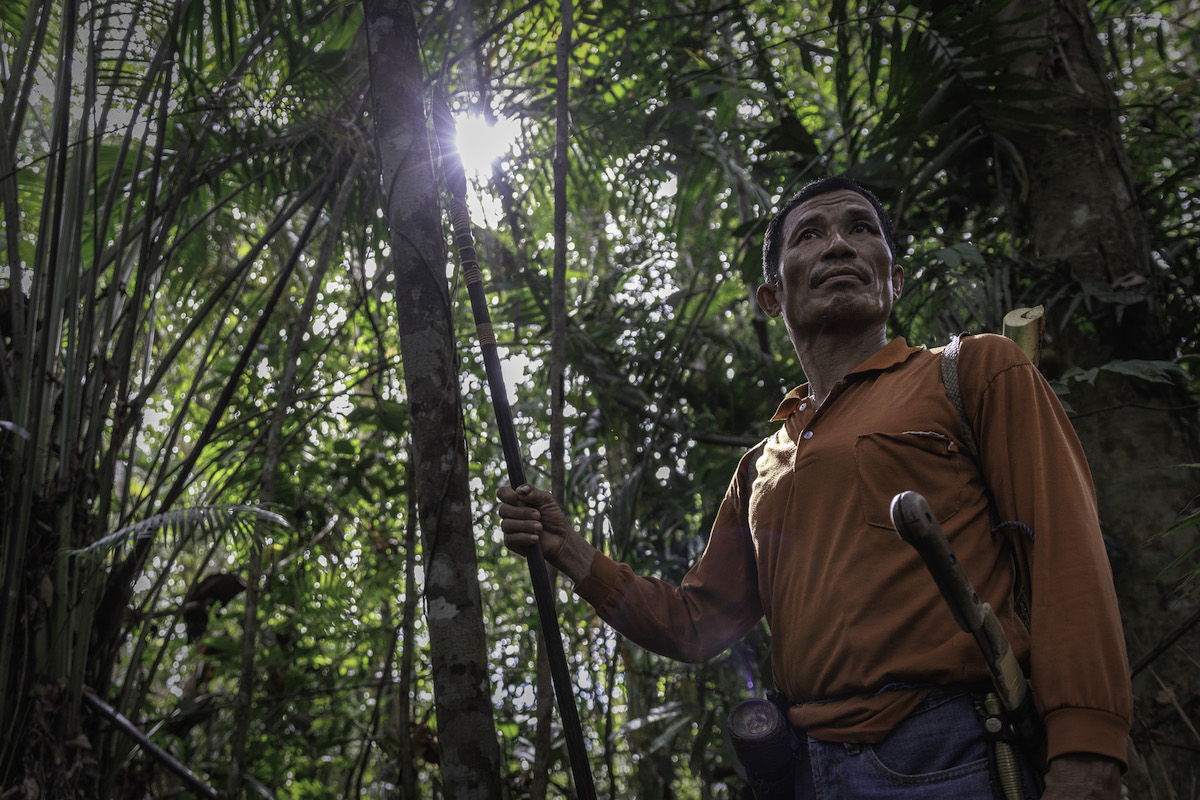
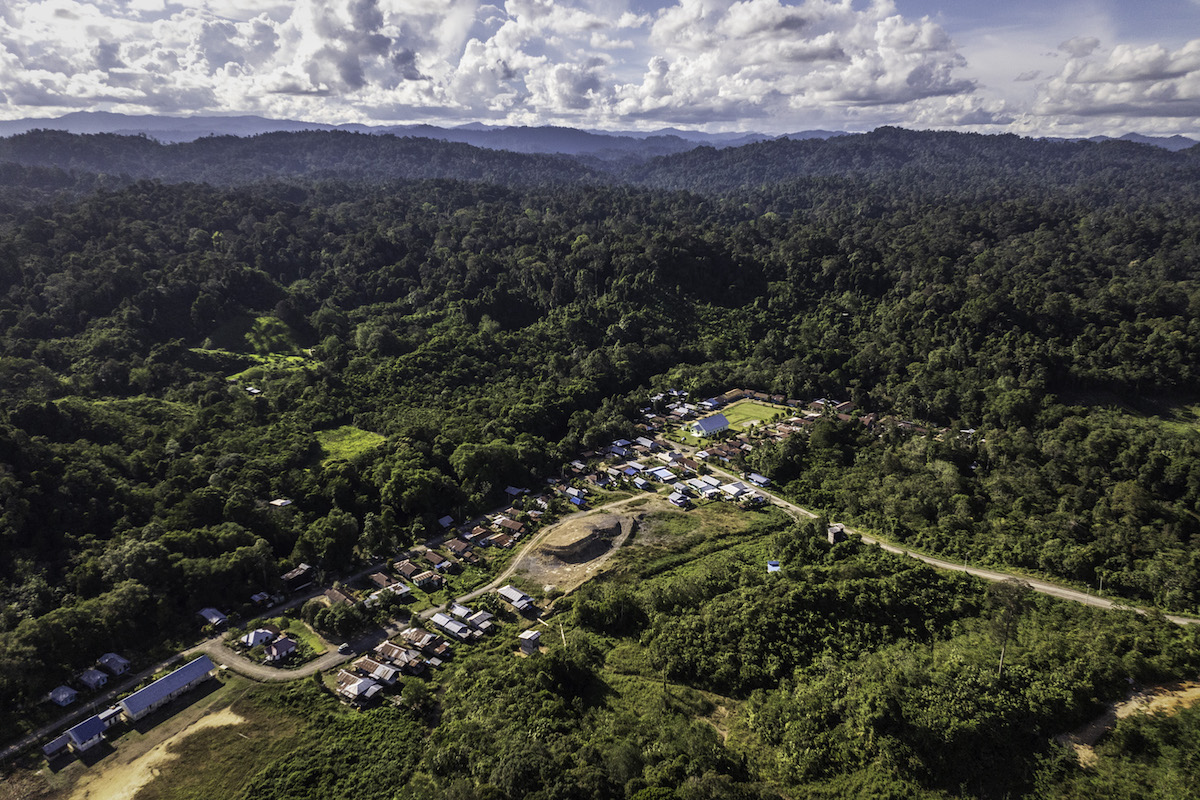
Indonesia is the world’s fourth-most-populous country and a top greenhouse gas emitter, with nearly half its energy coming from coal.
As the nation strives to make good on its pledges to cut fossil fuels, President Joko Widodo has promoted biomass energy, derived from burning plant and animal products, as a sustainable alternative. His administration, whose term came to an end on Oct. 20, has set ambitious targets to increase the burning of biomass alongside coal in power plants, a method known as cofiring, which is used extensively in Japan and South Korea.
PT Malinau Hijau Lestari (MHL), the company seeking to operate in Ipu’s village, Laban Nyarit, is one of many firms in Indonesia lining up to establish plantations of fast-growing tree species to produce wood pellets as biomass, classified by the government as a form of renewable energy. Indonesia’s wood pellets are slated for both domestic use and export to other countries.
Fears abound, however, that Indonesia’s biomass drive might come at the expense of its abundant but dwindling rainforests. A 2022 analysis by clean energy think tank Trend Asia concluded that meeting the government’s target to increase the portion of biomass burned in coal plants to 10% would require clearing at least 1 million hectares (2.5 million acres) of natural forest, an area twice the size of the island of Bali, in order to free up land for new plantations.
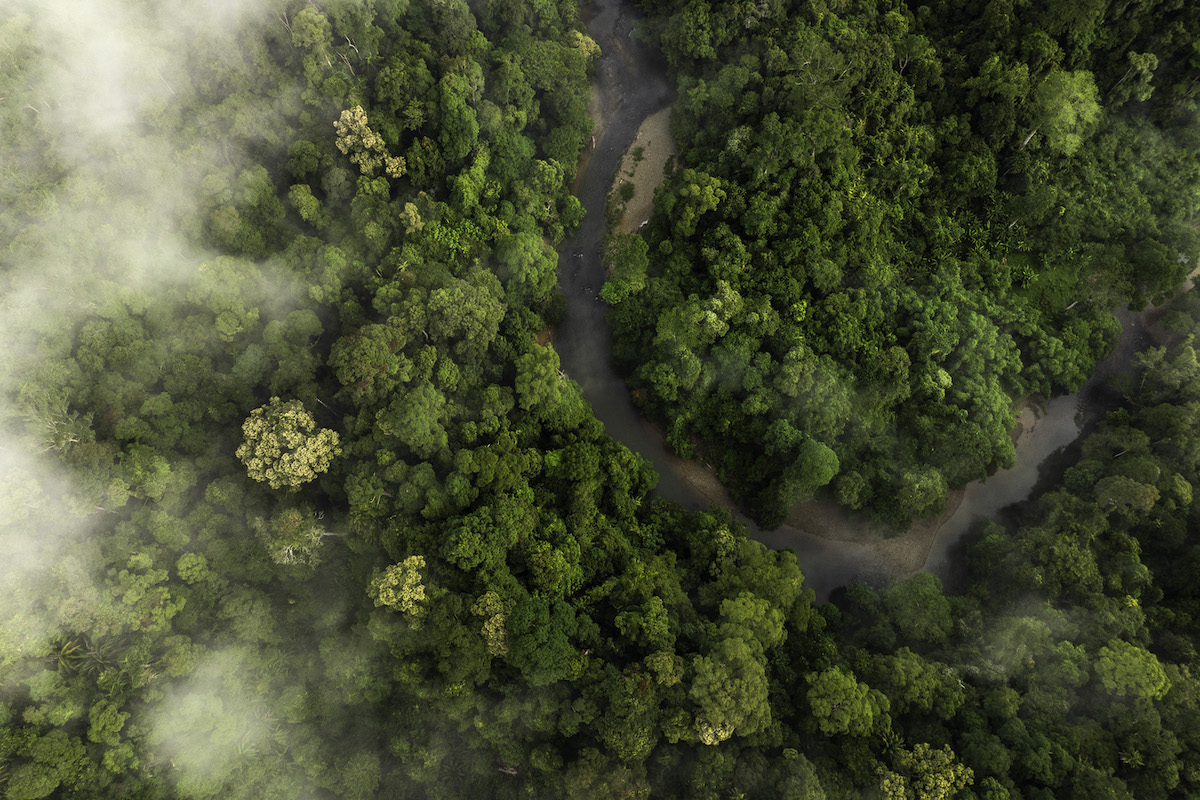
Indonesia’s state electricity utility, PLN, has said there’s ample unforested land available for new biomass estates. But deforestation for biomass has already emerged in Indonesia’s Papua region, where the billionaire-owned Medco conglomerate is bulldozing a rainforest for a wood plantation to supply a power plant it’s building, and on the Indonesian island of Sulawesi, where a pair of palm oil companies that recently had their permits revoked have subsequently begun clearing rainforest in order to harvest wood pellets for export.
After Mongabay received a tip that MHL had approached Ipu Angit’s village and three neighboring communities to acquire their lands for its own biomass energy venture, we traveled to the area to investigate.
The four villages are located in Malinau, a heavily forested district in North Kalimantan province that borders Malaysia’s Sarawak state on the giant island of Borneo. Malinau is larger than the U.S. state of Maryland but home to just 85,000 people, most of them Indigenous Dayaks.
Three of the villages — Laban Nyarit, Nunuk Tanah Kibang and Sengayan — have already signed over to MHL a total of at least 5,000 hectares (12,400 acres) for its biomass plantation, local residents and officials told us. Local leaders in a fourth village, Long Loreh, said their community had so far refused the company’s advances.
While MHL’s permits aren’t publicly available, Mongabay did obtain maps of its land concession from villagers who had received them directly from company officials. An analysis of the maps by the NGO Forest Watch Indonesia found that the concession covers 19,045 hectares (47,061 acres) — about twice the size of Paris — including around 15,000 hectares (37,000 acres) of standing rainforest, although it remains unclear how far MHL has advanced through the licensing process and whether the maps are final.
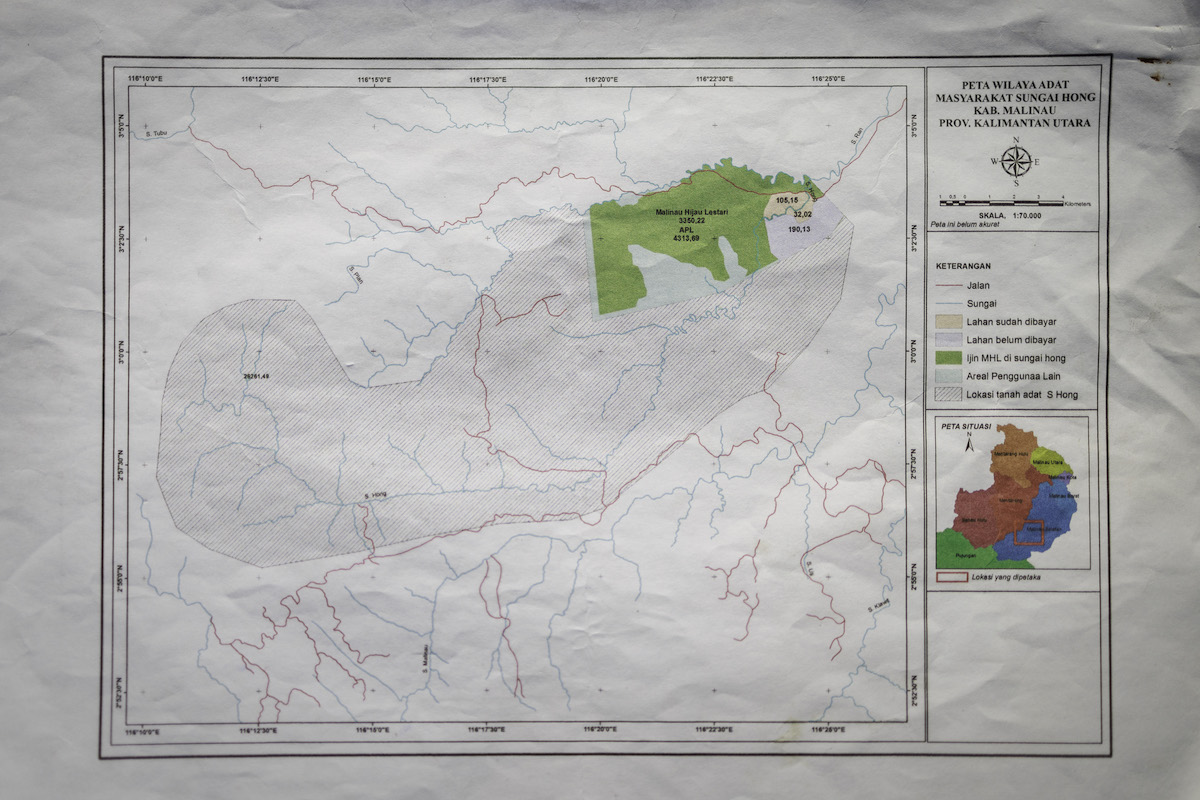
MHL’s parent company, publicly listed coal miner PT Mitrabara Adiperdana, said in May that MHL’s “license area” was 16,317 hectares (40,320 acres). That same figure was cited in a LinkedIn post by Prodesa, a Spanish firm assisting MHL in the construction of a wood pellet processing plant in Malinau.
The concession appears to have been drawn so as to skirt the boundaries of lands zoned as “forest” while encompassing lands zoned as “non-forest,” which are known in Indonesia as APL. In reality, though, many of Indonesia’s APL lands are actually covered in rainforest, meaning that a project on APL lands could actually result in extensive deforestation.
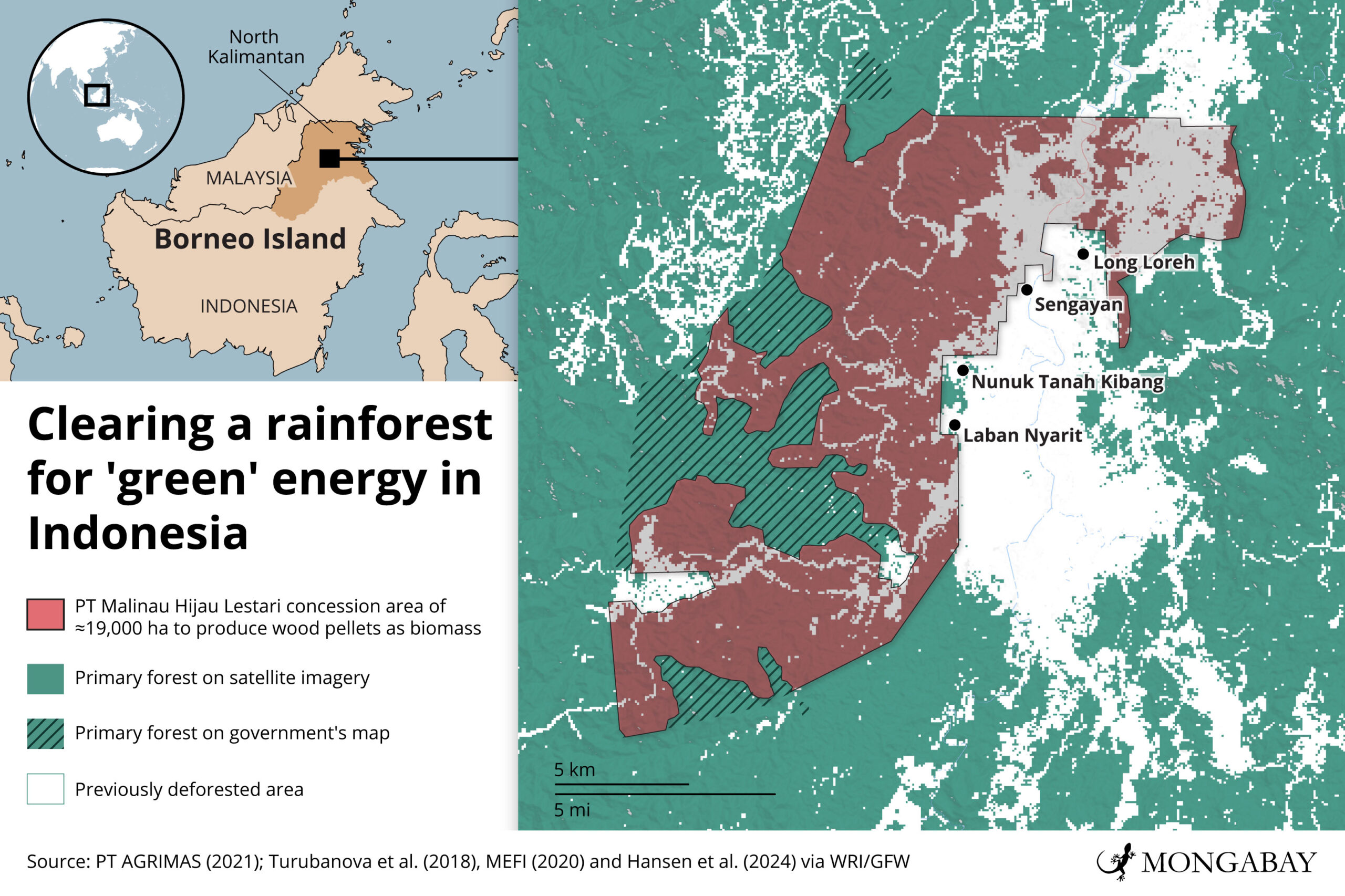
Mitrabara has downplayed deforestation concerns, with its CEO, Khoirudin, saying in response to a question from a Mongabay reporter at an annual shareholder meeting in May that MHL’s plantation would make use of degraded lands. (The company did not otherwise respond to requests for an interview or comment on a detailed list of findings to be published as part of this story.)
Villagers on the ground, however, told Mongabay that much of the land MHL had already acquired from their communities for the biomass project remained covered in rich rainforest.
In Laban Nyarit village, Mongabay observed MHL signposts indicating that the surrounding area, much of it densely forested, had been earmarked for its concession. Interviewees in all three of the villages that have agreed to deals with MHL told us the lands signed over included forest.
“The company said, ‘We’re going to clear the forests first, and then we’re going to plant [trees for wood pellet production] to replace the coal. Because there’s no more coal,’” Ipu Angit said, recounting a 2020 meeting at which MHL representatives addressed locals.
“We started whispering [to each other], ‘Hey, what will happen to our forests if they’re cleared?’”
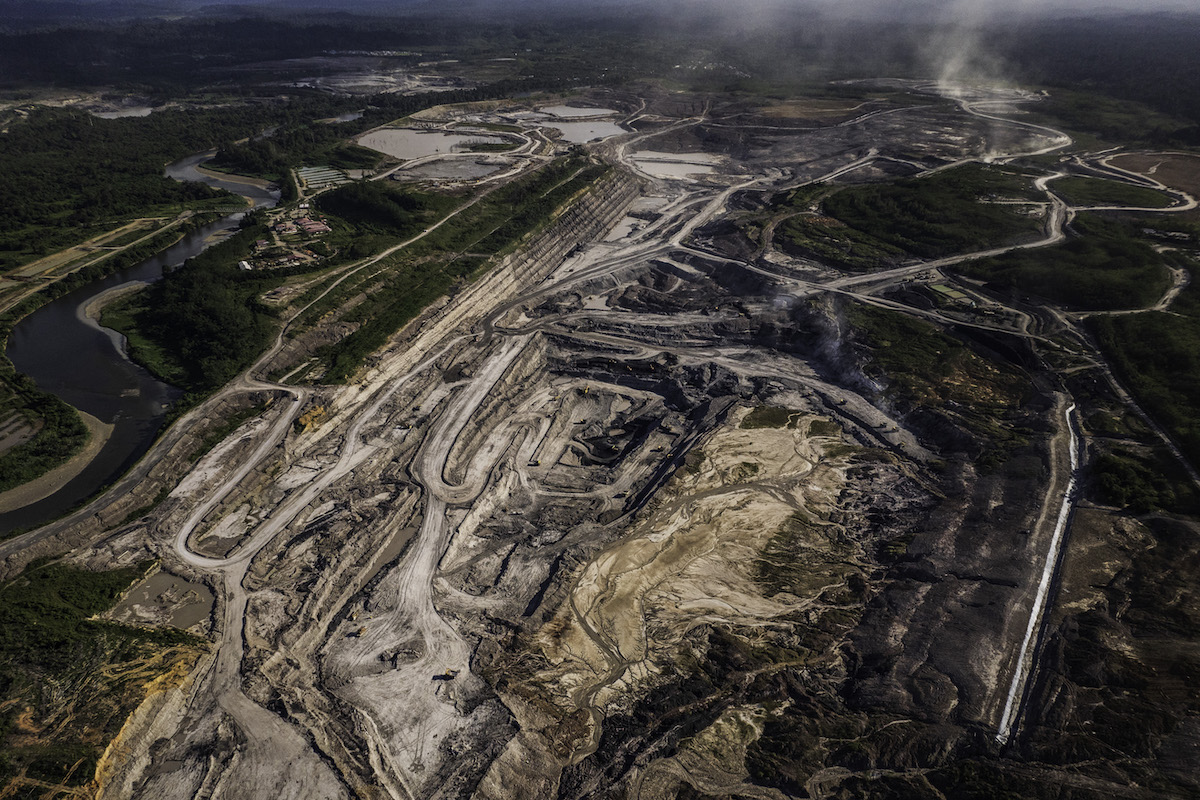
MHL’s plantation is among a number of nascent or planned megaprojects that promise to alter the landscape of Kalimantan, the Indonesian part of Borneo.
An eight-hour drive south of Laban Nyarit, a vast industrial park being built to service industries like electric vehicles and solar panels is spreading over a coastal area used by endangered sea turtles and local fishermen.
To power the park, a $2.6 billion dam is being built on the Mentarang River in Malinau, on the threshold of a huge tract of pristine forest home to Indigenous communities.
A series of five more dams, touted as Southeast Asia’s largest hydropower project, has been planned for the Kayan River in neighboring Bulungan district, in part to support the growth of Indonesia’s new capital city, Nusantara, which the national government is building from scratch.
Unlike other parts of Borneo that are dominated by plantations and mines, North Kalimantan remains scarcely touched by heavy industry, with around four-fifths of the province still forested, according to data from forest monitoring platform Nusantara Atlas.
Malinau is no exception. A 2002 survey of the district revealed vast biological wealth, much of it unknown to science.
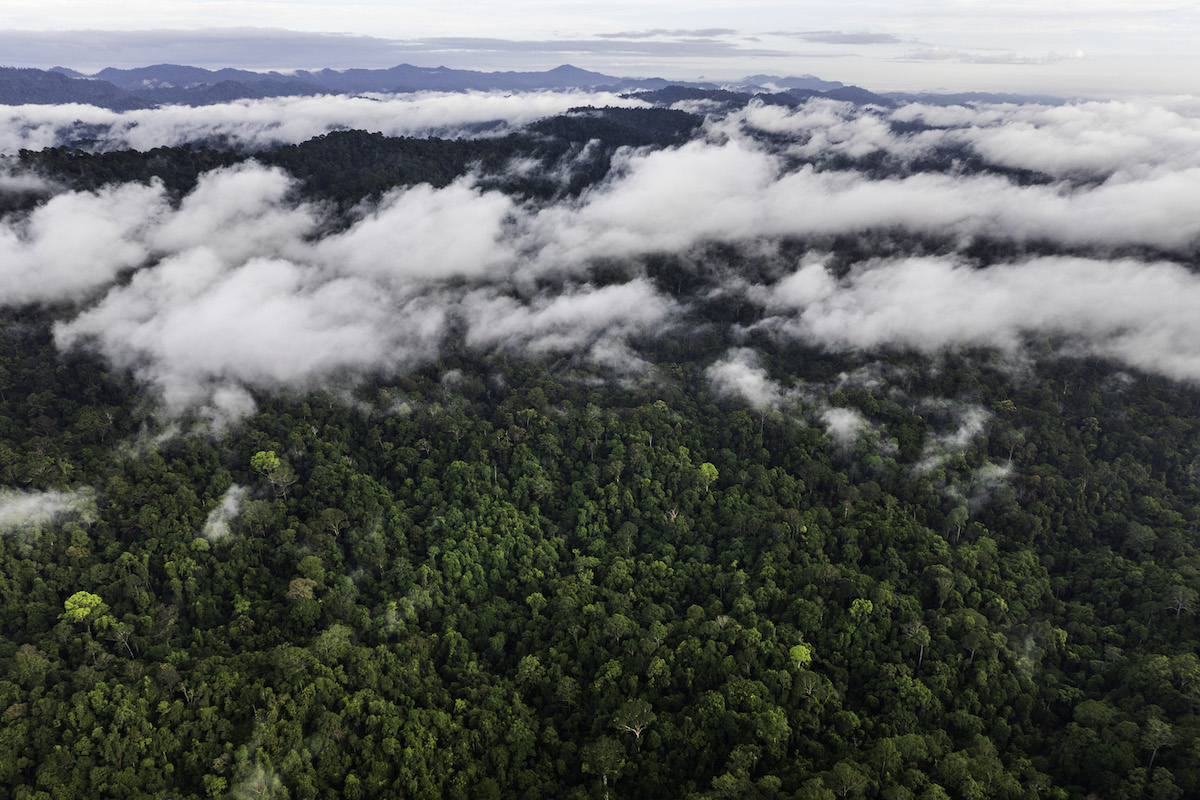
In MHL’s project area, concerns over deforestation have been accompanied by allegations of unfair dealmaking, with the villages that have entered into a pact with the firm receiving varying terms.
Two villages, Laban Nyarit and Nunuk Tanah Kibang, each got a one-time fee of 1 million rupiah per hectare (about $26 per acre) in exchange for signing over the rights to 2,500 and 300 hectares (6,200 and 740 acres), respectively, locals told Mongabay.
A third village, Sengayan, got a more lucrative deal, with a 20% profit-sharing arrangement in addition to compensation for land and for trees felled.
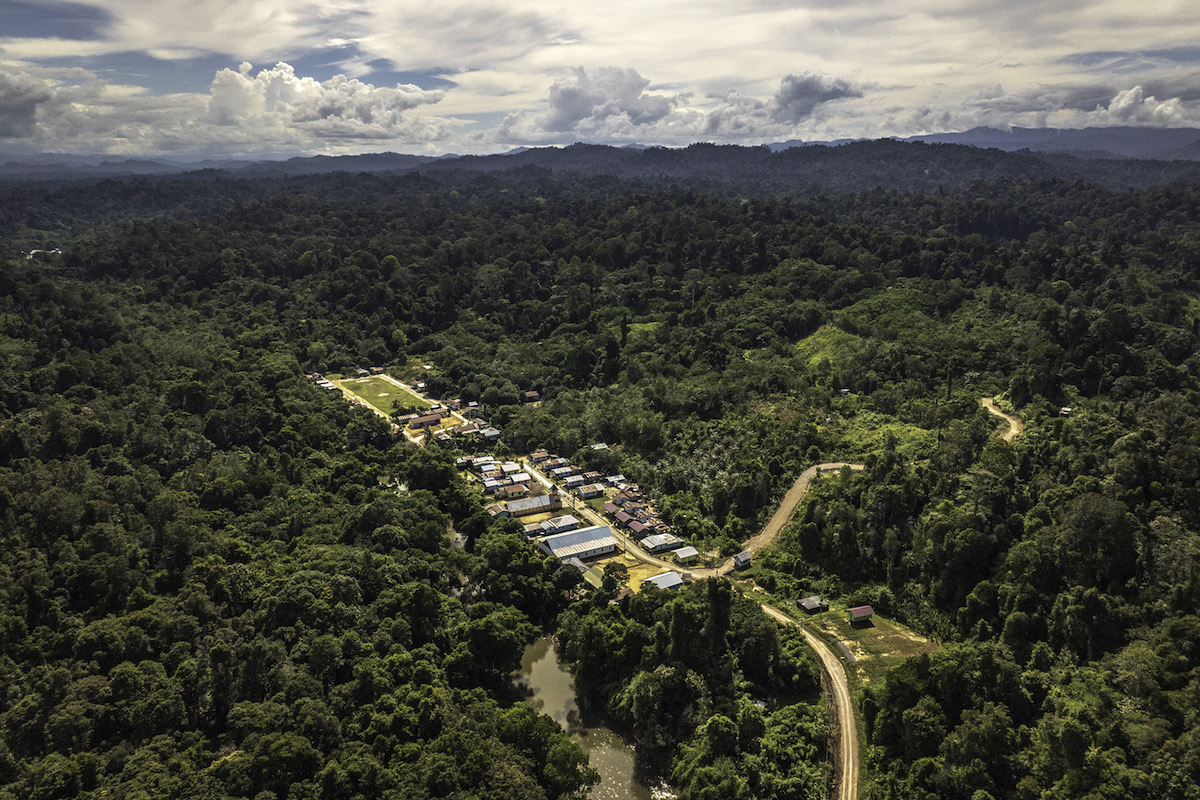
Arifin Liah, the elected chief of Sengayan, said he’d prioritized securing a continuous flow of income in his negotiations with MHL. The company, he said, had asked for 6,000 hectares (14,800 acres), but he’d only agreed to 2,200 hectares (5,400 acres).
Arifin’s father, Liah Lungung, said he could live with those terms. “Laban Nyarit and Nunuk Tanah Kibang will be upset once the money runs out,” he said in an interview at his home in Sengayan, as a throng of friends and family members busily prepared for his grandchild’s wedding.
In Nunuk Tanah Kibang, some residents initially objected to the plan, but village and subdistrict officials eventually convinced them to accept it, according to Malik, who runs a village-owned enterprise in the community.
When the company presented its plan, Malik said, “We were only focused on the money, so we just said yes … We don’t know much, we don’t have a lot of education here, and we didn’t grasp what the future impact would be. So at the time we were fine with it, and we welcomed MHL into our village.”
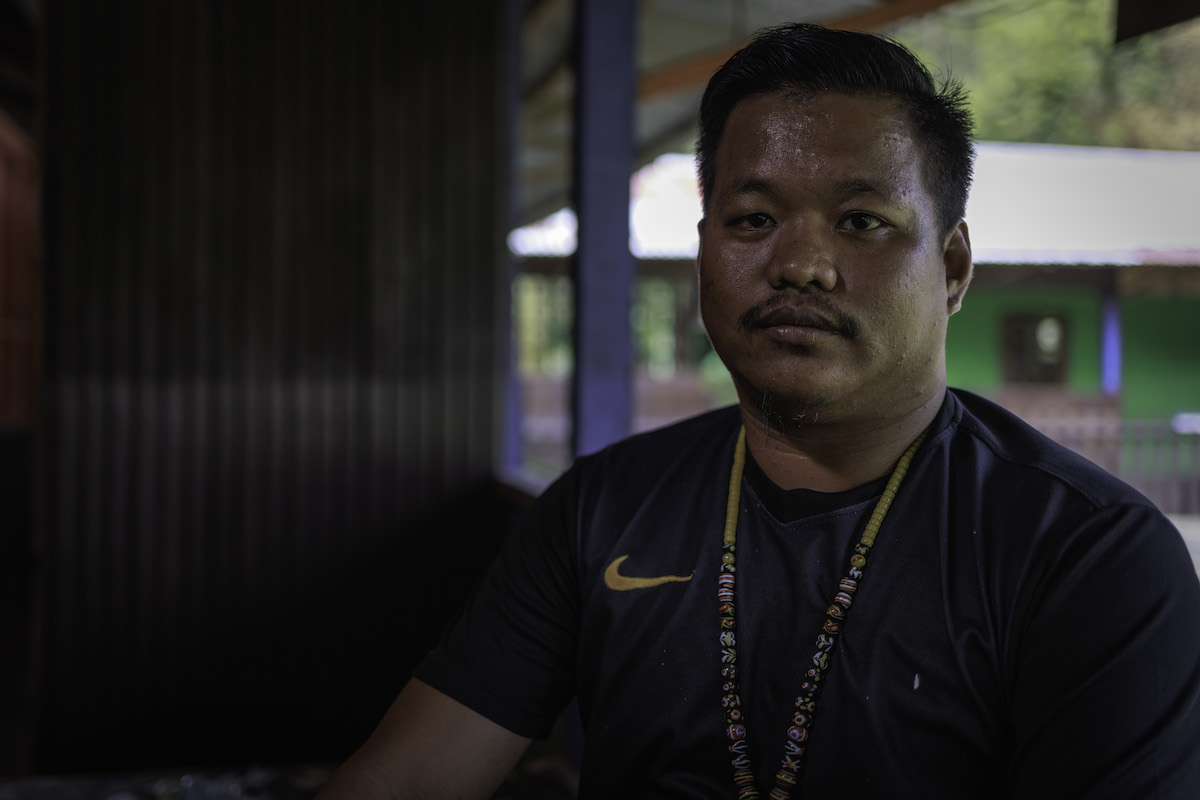
In Laban Nyarit, no one ever explained the environmental downsides of the project, according to Ipu Angit and his family. The village chief, they said, just insisted they would all get rich. “He said we’d all have cars in front of our houses,” Ipu’s son Alang told Mongabay.
The company ended up paying compensation worth only 1 million rupiah per hectare, with no compensation for trees to be felled, Ipu said. Ipu’s wife, Uray Alang, called the figure — amounting to around $160,000 for 2,500 hectares of land, much of it forested — an insult.
“What can we eat from 1 million rupiah per hectare?” she said. “What kind of land is priced like that?”
Such modest land compensation is not uncommon in Indonesia, where Indigenous and other rural communities often have little leverage to refuse or negotiate with well-connected developers. In 2017, for example, a palm oil firm was found to have deprived communities in Papua of an astounding $300 million by failing to pay commercial rates for the timber harvested from their lands.
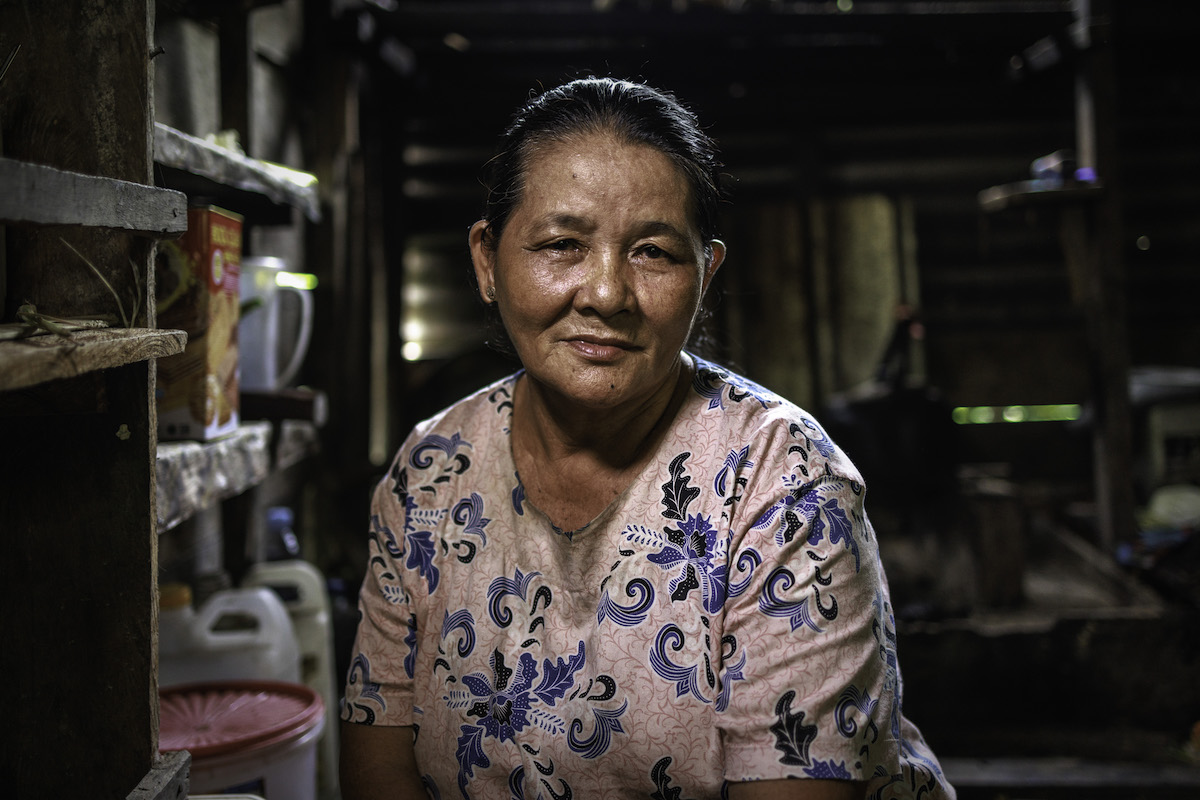
Ipu and Uray said MHL tried to pressure them into accepting its offer, and that when that didn’t work, it seized their lands anyway.
Since 2022, they were summoned at least six times to meet MHL representatives in the Malinau district seat, they said. One or both of the couple, they recounted, would be picked up at their hut, sometimes in the dead of night, and driven two hours to a restaurant in town, where company officials, the village chief and police officers were waiting. Uray said the ordeal caused her great distress.
“If we sell, where will we go?” Uray told Mongabay. “Where will our children and grandchildren go? What will they eat? Where will they go for livelihoods?”
Despite their objections, the family said, MHL proceeded to map their lands as a part of the area earmarked for the biomass project.
Last year, an MHL signpost appeared a five-minute walk Ipu and Uray’s hut, on lands inherited from his ancestors, saying villagers were barred from cutting trees or hunting in the forest. Ipu told Mongabay he never consented to the land rights transfer and hadn’t received a penny from MHL.
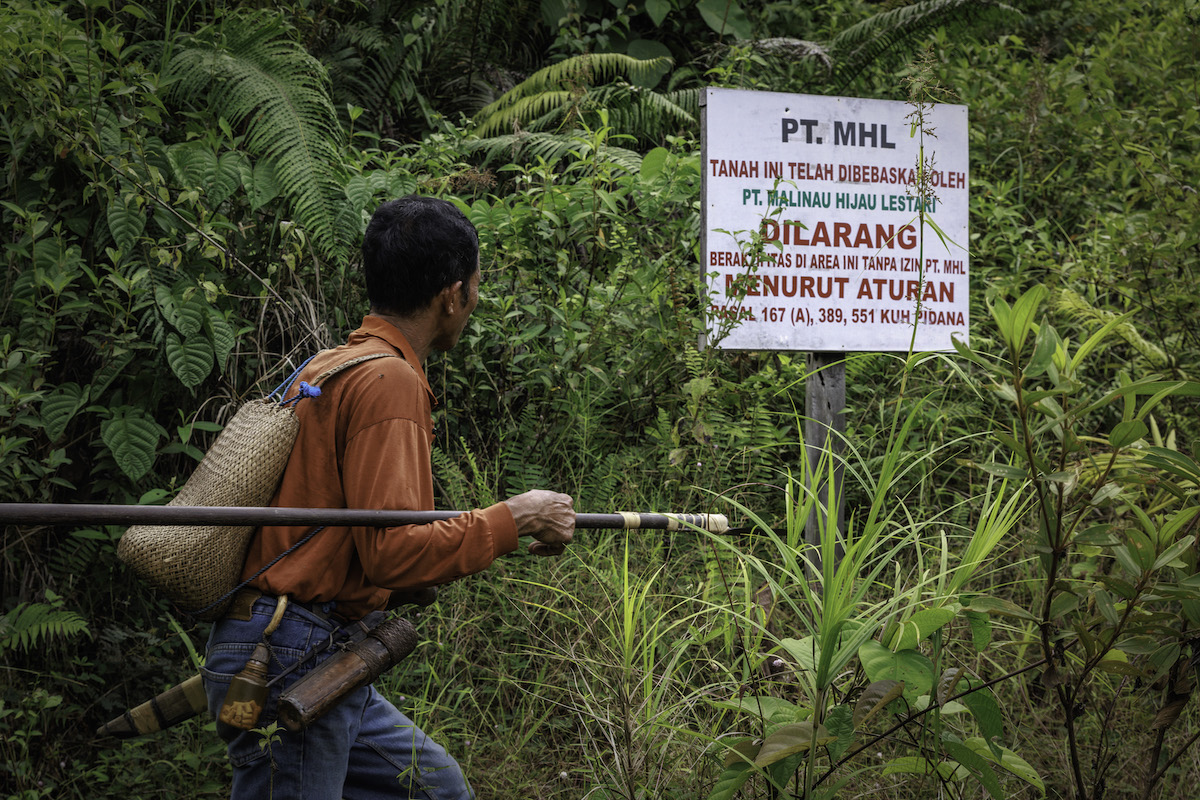
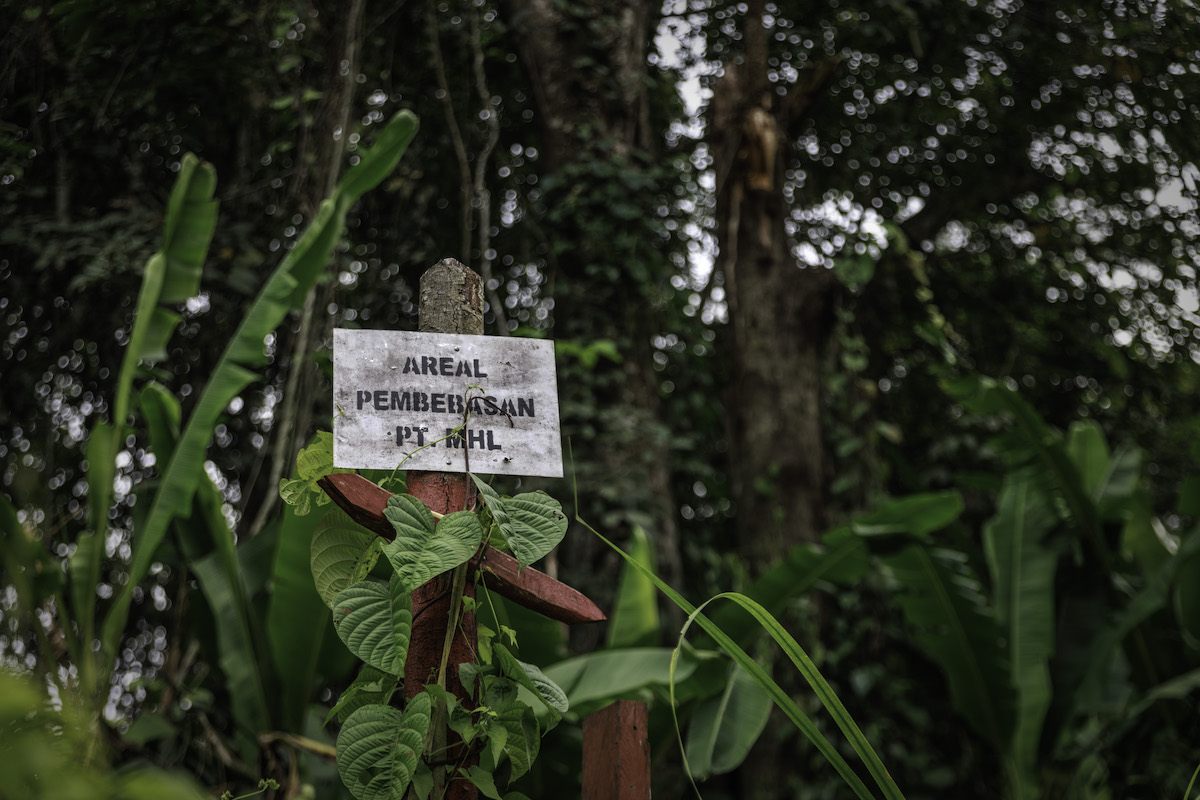
While they weren’t physically threatened, the use of the police to escort developers is a classic means of intimidating villagers in Indonesia, according to Amalya Reza Oktaviani, biomass program manager with Trend Asia.
“This is a case of land grabbing, because there’s not enough information [being given to the villagers], so there’s no meaningful participation in the dialogue,” she said. “Even if there are signatures [from villagers or village chiefs], it doesn’t necessarily mean they’ve consented.”
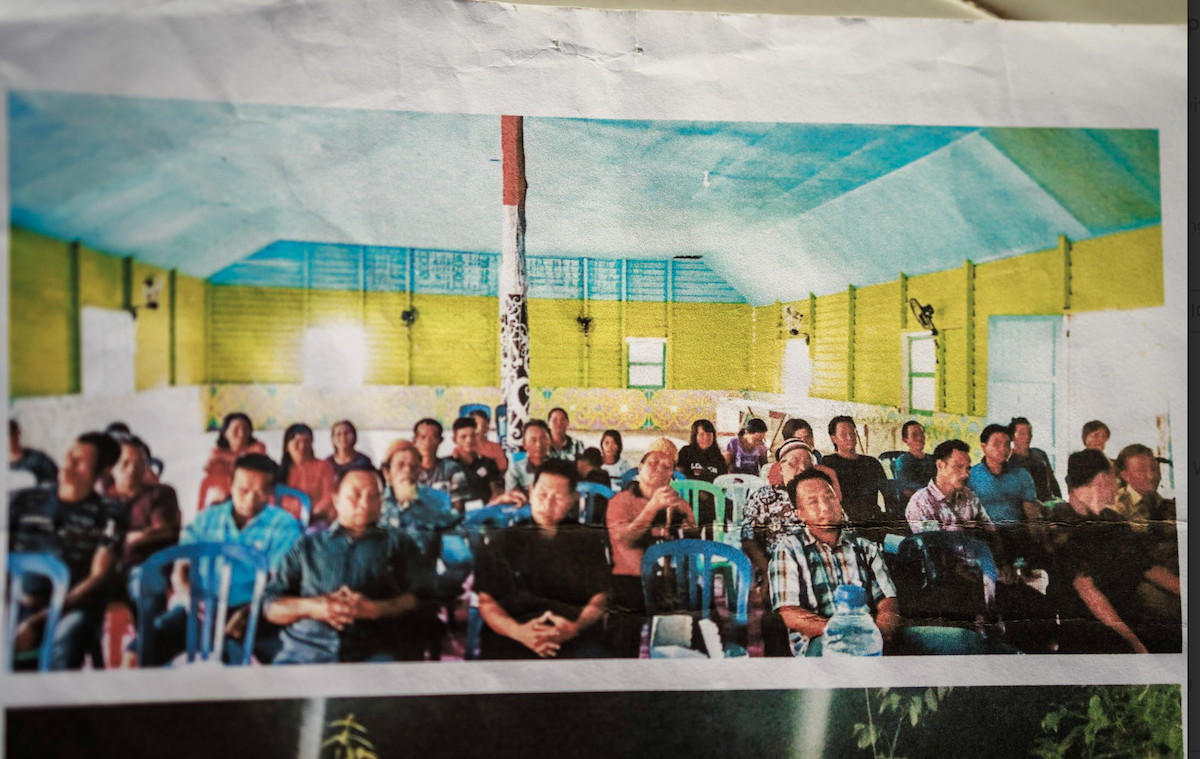
Long Loreh, the fourth village, has so far rejected MHL’s overtures.
This village operates some tourism enterprises, and its Indigenous traditions remain strong. There are a number of local businesses as well, in part due to its proximity to a coal mine long run by Mitrabara, the MHL parent company.
Locals remember how Mitrabara failed to keep its promises to provide free education after setting up shop in the village in 1992, according to Firi, a former secretary in the Long Loreh village office.
They also blame the company for polluting a river and have staged several protests about that, he said.
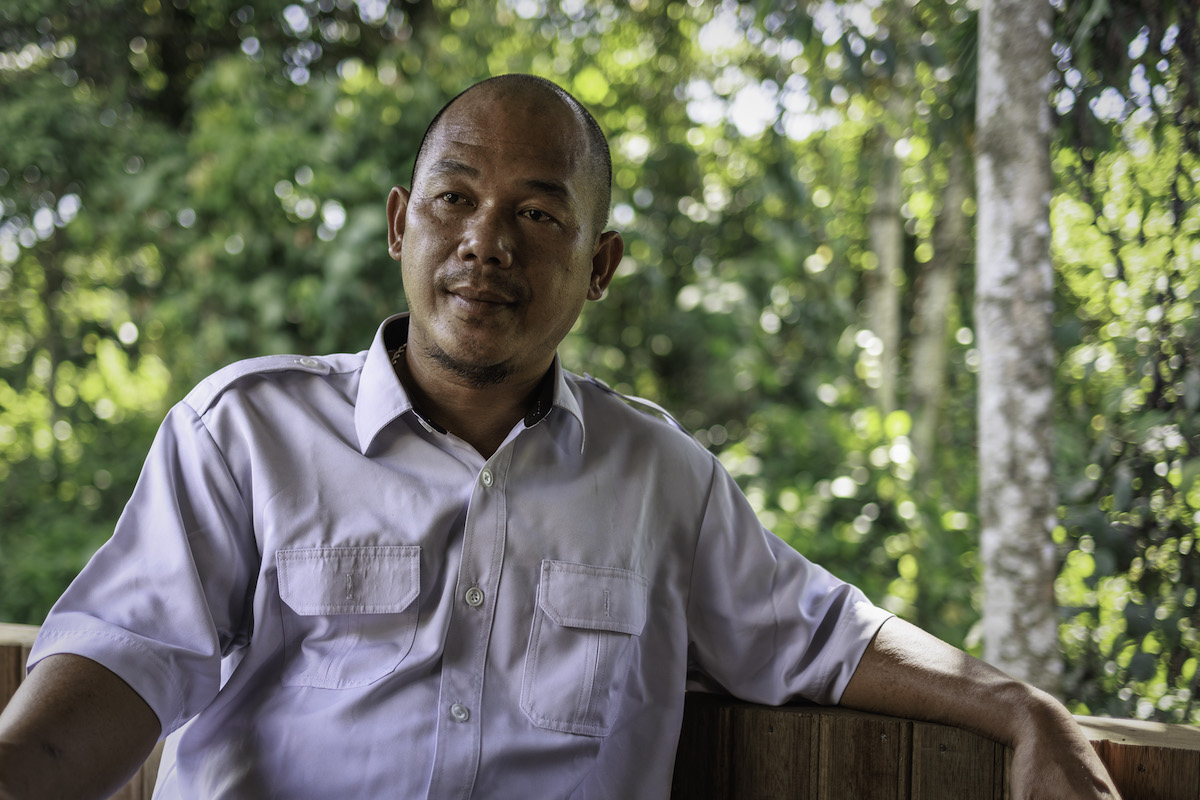
More recently, while some villagers were tempted by MHL’s offer, Firi and others were strongly opposed. Firi said the latter group had a clearer idea than the other villagers of what their natural assets were worth, and knew the company was offering them paltry compensation.
MHL had offered Long Loreh 1.5 million rupiah ($97) per hectare (about $39 per acre) to lease 2,100 hectares (5,200 acres) for 35 years, Firi said. He argued the amount was far too little. The community would have received 3.15 billion rupiah ($203,000), amounting to 1.75 million rupiah ($113) per person — barely more than the average cost to live in Malinau for just one month, according to Indonesia’s statistics agency.
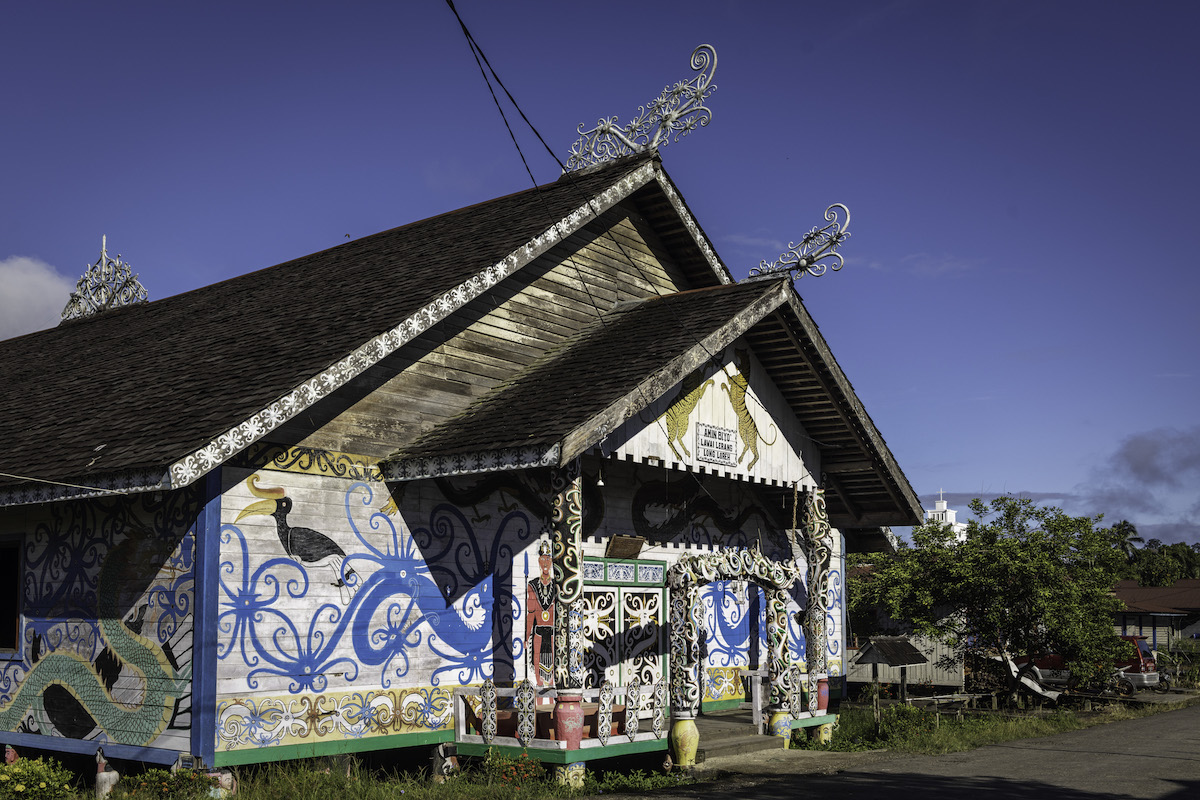
On one occasion, Firi was visited at home by six MHL representatives, who wanted to know why he insisted on refusing the company’s offer. He asked the visitors to put themselves in the villagers’ shoes.
“All of you are intelligent people,” Firi recounted telling the visitors. “Imagine you all live here, and a company called MHL comes and makes an offer like that.
“How do you think that would work out for our future generations? Have a good think about that before you come and tell me anything.”
Surrendering a forest Firi estimated was worth hundreds of millions of dollars “isn’t worth it,” he said.
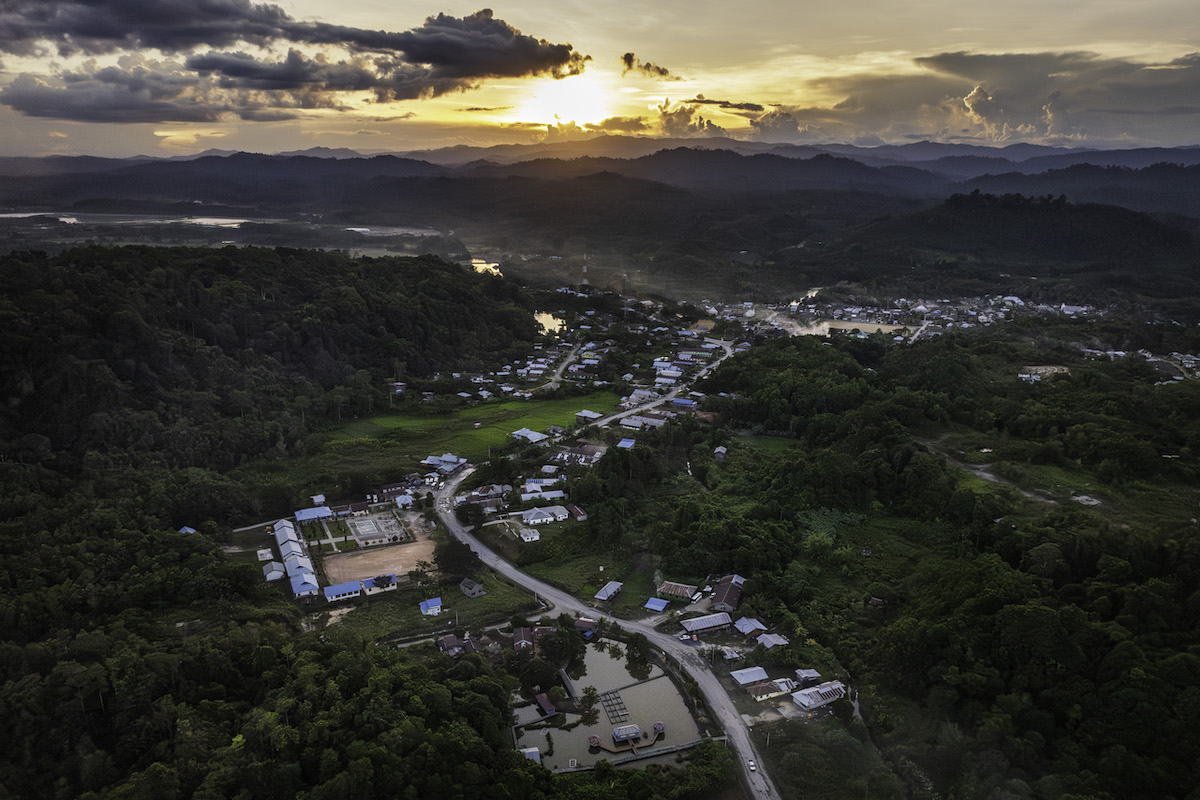
MHL’s plantation may herald a succession of biomass energy projects in North Kalimantan. The province’s forestry agency said in June it had identified 689,635 hectares (1.7 million acres) where renewables investors could potentially set up biomass estates. Around a third of that is in Malinau district, the agency said.
All of that land is currently zoned as non-forest, or APL, while regulations mandate that wood pellet plantations can only be established on areas zoned as forest. The agency has therefore asked Jakarta to create a licensing framework for wood plantations on APL lands so that projects like MHL’s may legally proceed.
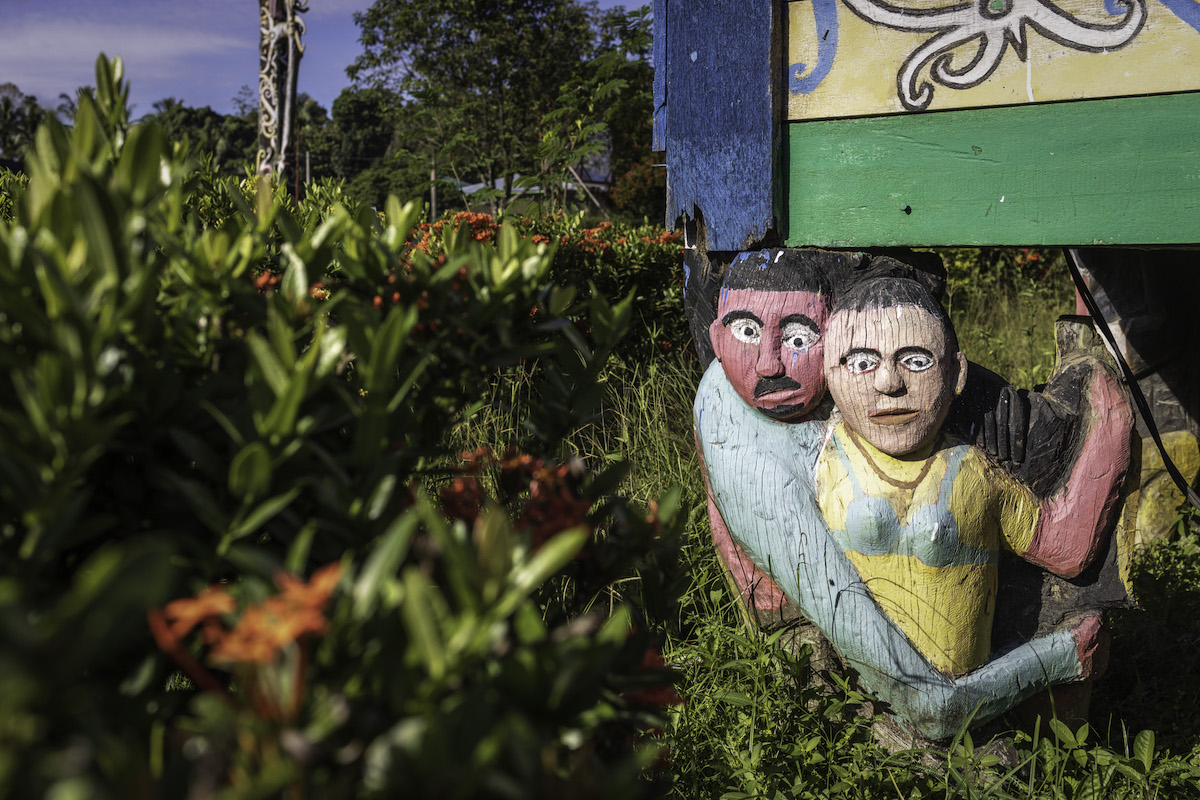
Despite its zonation, much of the APL land in North Kalimantan is actually covered in standing rainforest, according to a recent analysis by the NGO Auriga Nusantara. That rainforest should be protected, not demolished in the name of green energy, Forest Watch Indonesia campaigner Agung Ady Setyawan told Mongabay.
MHL appears to still be navigating the licensing process; Khoirudin, the Mitrabara CEO, said at the May shareholders’ meeting that MHL had secured three permits: a spatial utilization approval (PKKPR), which confirms that the project’s spatial plan aligns with regional plans; a location permit, obtained in 2018, which allows the company to negotiate with villagers for the rights to use their land; and an environmental permit, which is supposed to be issued after a company carries out and gets approval for an environmental impact assessment.
The company has already established a 16-hectare (40-acre) demonstration plot on lands leased from villagers, locals said.
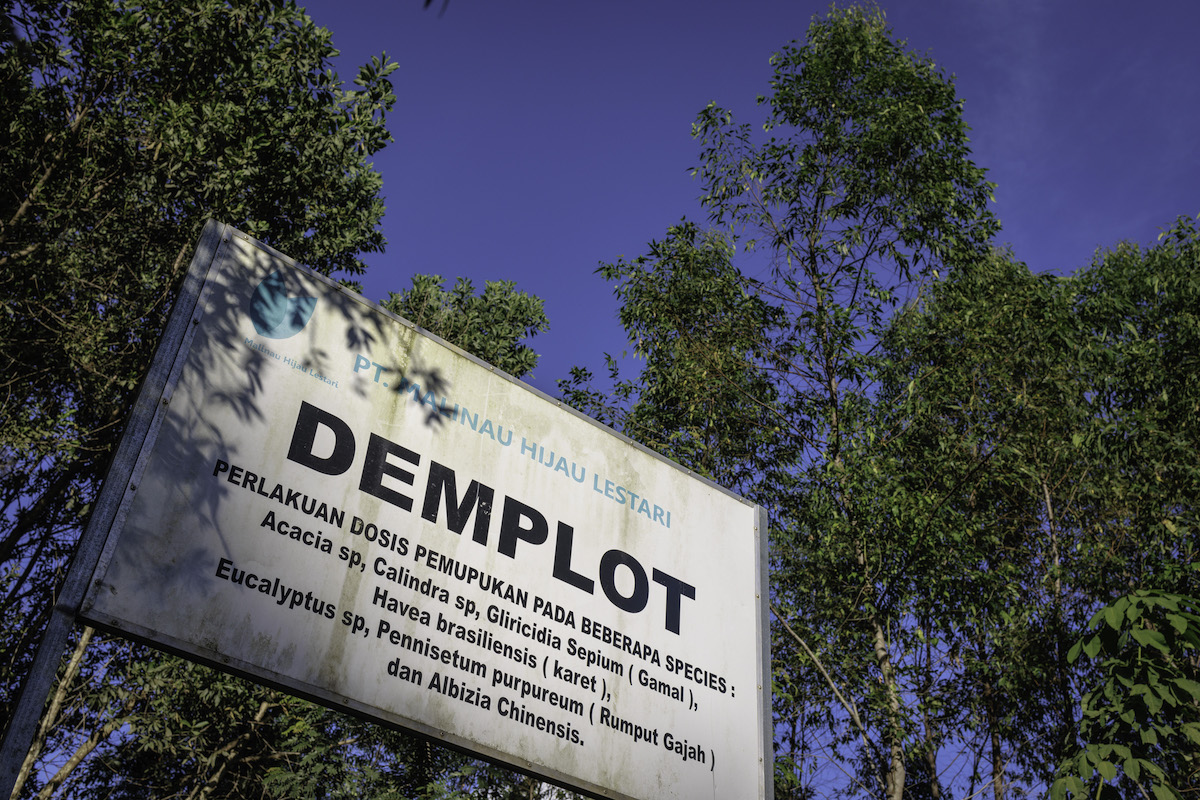
Mitrabara’s 2023 annual report says MHL broke ground last November on a wood pellet processing plant in Malinau. Japan’s Toyo Engineering is building the factory, while Spain’s Prodesa is providing technical support. Singapore’s OCBC Bank has lent $51.24 million to finance its construction.
Where MHL will sell its wood pellets remains unclear. Khoirudin said at the shareholders’ meeting that they would be exported overseas, but that the company had yet to lock down any buyers.
One possibility is South Korea, where Mitrabara already sends much of its coal. South Korea is Asia’s largest importer of wood pellets, with 95% of its supply coming from Indonesia, Vietnam and Malaysia. As the number of biomass power plants in South Korea steadily rises, its demand for wood pellets is projected to rise to 6 million metric tons by 2025.
New biomass power plants also continue to come online in Japan, which invested heavily in coal-biomass cofiring for its energy after the Fukushima nuclear meltdown. How much of Indonesia’s wood might be exported to Japan is unknown, but it could be a ready market. However, there’s a growing understanding among Japanese activists and some policymakers that biomass has significant negative environmental and climate impacts.
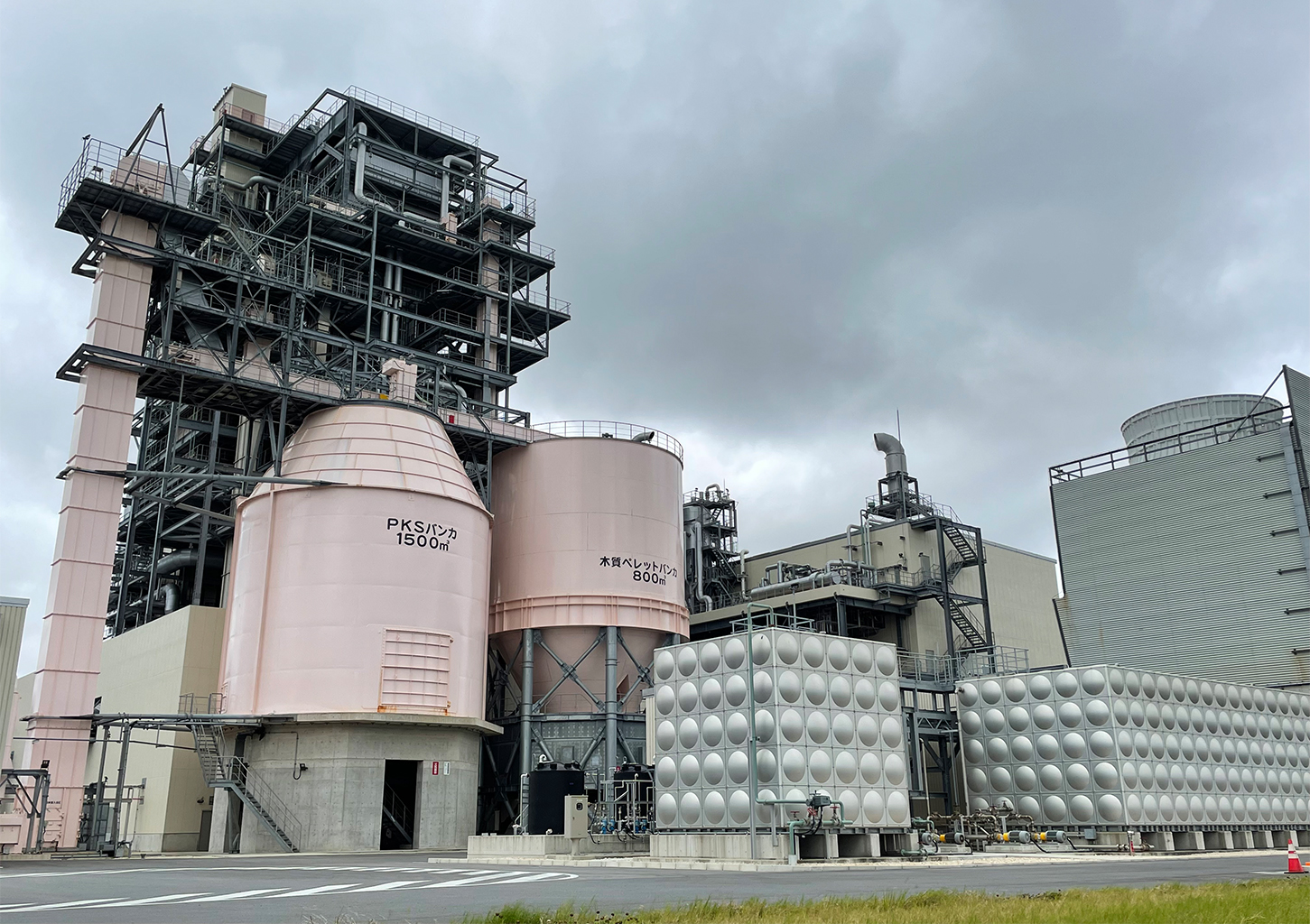
Scientists have long cautioned that burning wood to provide energy at an industrial scale is not sustainable, and in fact is dirtier than coal: Burning wood emits more climate change-causing CO2 than coal per unit of electricity produced.
Wood pellets produced from the destruction of rainforests can’t be described as green energy, according to Trend Asia’s Amalya.
Japan, South Korea and other countries, she said, “have to know that the wood they burn to warm them up and generate electricity comes from the loss of natural forest, wildlife and its habitat, sources of water and food, and lands of Indigenous peoples in Indonesia.”
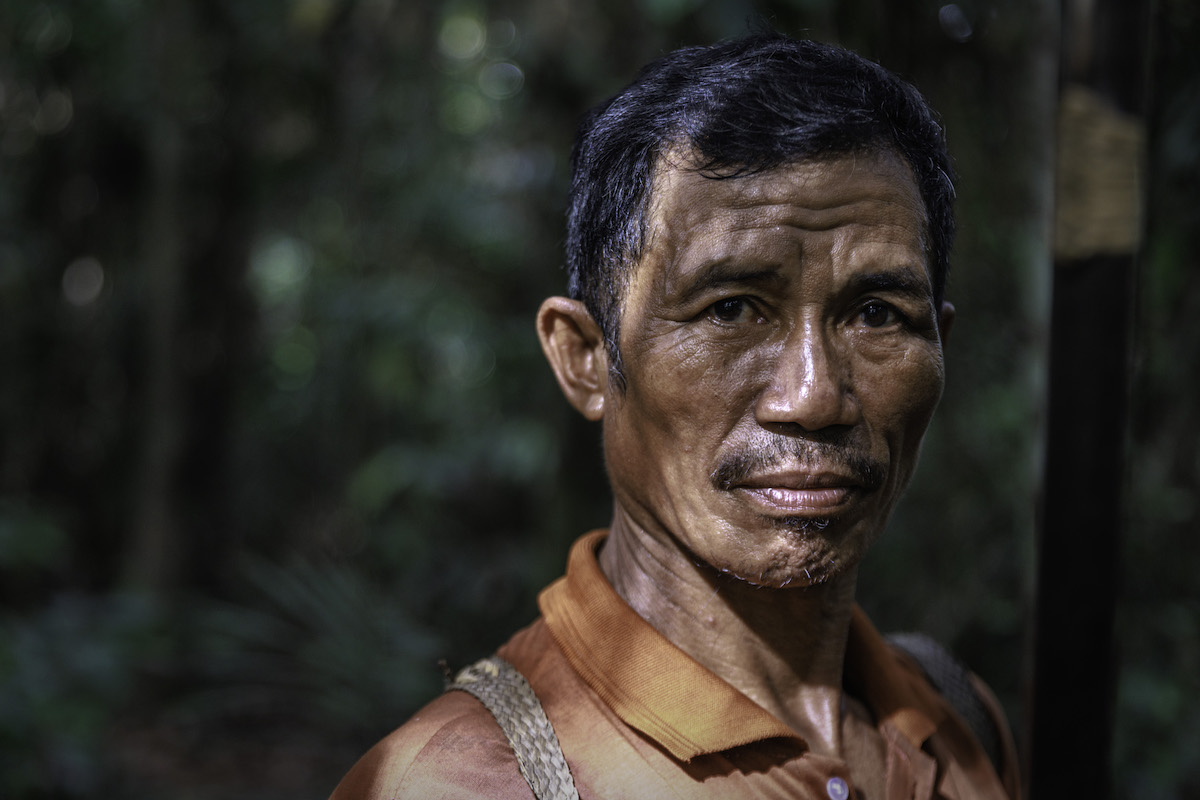
In the future, these lands might include the forest where Ipu goes to look for food.
“Everywhere we walk in the forest, we won’t go hungry. Because everything we hope for are here in the forest,” Ipu said, tears coming to his eyes.
“Until now, I still need the forest. Here, we say ‘Tu’an telang otah inan kai,’ which means ‘the forest is our mothers’ milk.’”
FEEDBACK: Use this form to send a message to the author of this post. If you want to post a public comment, you can do that at the bottom of the page.
Search
RECENT PRESS RELEASES
Related Post




